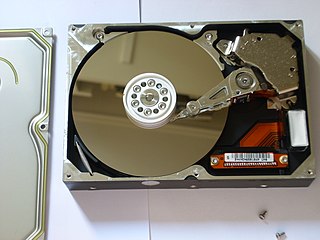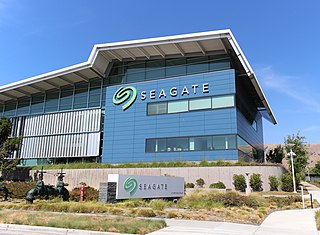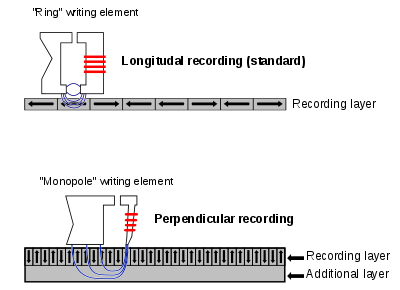
A hard disk drive (HDD), hard disk, hard drive, or fixed disk, is an electro-mechanical data storage device that stores and retrieves digital data using magnetic storage with one or more rigid rapidly rotating platters coated with magnetic material. The platters are paired with magnetic heads, usually arranged on a moving actuator arm, which read and write data to the platter surfaces. Data is accessed in a random-access manner, meaning that individual blocks of data can be stored and retrieved in any order. HDDs are a type of non-volatile storage, retaining stored data when powered off. Modern HDDs are typically in the form of a small rectangular box.

A hard disk drive platter or hard disk is the circular magnetic disk on which digital data is stored in a hard disk drive. The rigid nature of the platters is what gives them their name. Hard drives typically have several platters which are mounted on the same spindle. A platter can store information on both sides, typically requiring two recording heads per platter, one per surface.

A disk read-and-write head is the small part of a disk drive which moves above the disk platter and transforms the platter's magnetic field into electric current or, vice versa, transforms electric current into magnetic field. The heads have gone through a number of changes over the years.

Western Digital Corporation is an American computer drive manufacturer and data storage company, headquartered in San Jose, California. It designs, manufactures and sells data technology products, including data storage devices, data center systems and cloud storage services.

Seagate Technology Holdings plc is an American data storage company. It was incorporated in 1978 as Shugart Technology and commenced business in 1979. Since 2010, the company has been incorporated in Dublin, Ireland, with operational headquarters in Fremont, California, United States.

Magnetic storage or magnetic recording is the storage of data on a magnetized medium. Magnetic storage uses different patterns of magnetisation in a magnetizable material to store data and is a form of non-volatile memory. The information is accessed using one or more read/write heads.
Density is a measure of the quantity of information bits that can be stored on a given length of track, area of the surface, or in a given volume of a computer storage medium. Generally, higher density is more desirable, for it allows more data to be stored in the same physical space. Density therefore has a direct relationship to storage capacity of a given medium. Density also generally affects the performance within a particular medium, as well as price.
Millipede memory is a form of non-volatile computer memory. It promised a data density of more than 1 terabit per square inch, which is about the limit of the perpendicular recording hard drives. Millipede storage technology was pursued as a potential replacement for magnetic recording in hard drives and a means of reducing the physical size of the technology to that of flash media.

The Microdrive is a type of miniature, 1-inch hard disk produced by IBM and Hitachi. These rotational media storage devices were designed to fit in CompactFlash (CF) Type II slots.
In computing, a hybrid drive is a logical or physical storage device that combines a faster storage medium such as solid-state drive (SSD) with a higher-capacity hard disk drive (HDD). The intent is adding some of the speed of SSDs to the cost-effective storage capacity of traditional HDDs. The purpose of the SSD in a hybrid drive is to act as a cache for the data stored on the HDD, improving the overall performance by keeping copies of the most frequently used data on the faster SSD drive.
Heat-assisted magnetic recording (HAMR) is a magnetic storage technology for greatly increasing the amount of data that can be stored on a magnetic device such as a hard disk drive by temporarily heating the disk material during writing, which makes it much more receptive to magnetic effects and allows writing to much smaller regions.

HGST, Inc. was a manufacturer of hard disk drives, solid-state drives, and external storage products and services.

Travelstar was a brand of 2.5-inch hard disk drive (HDD) that was introduced by IBM in 1994 with the announcement of the Travelstar LP. At 12.5 mm high with two platters, they were available in 360, 540 and 720 MB capacities. Initial models were industry-leading for small form factor HDDs in terms of areal density, data transfer rates and shock tolerance (500g).
Mark Howard Kryder was Seagate Corp.'s senior vice president of research and chief technology officer. Kryder holds a Bachelor of Science degree in electrical engineering from Stanford University and a Ph.D. in electrical engineering and physics from the California Institute of Technology.

In 1953, IBM recognized the immediate application for what it termed a "Random Access File" having high capacity and rapid random access at a relatively low cost. After considering technologies such as wire matrices, rod arrays, drums, drum arrays, etc., the engineers at IBM's San Jose California laboratory invented the hard disk drive. The disk drive created a new level in the computer data hierarchy, then termed Random Access Storage but today known as secondary storage, less expensive and slower than main memory but faster and more expensive than tape drives.
Patterned media is a potential future hard disk drive technology to record data in magnetic islands, as opposed to current hard disk drive technology where each bit is stored in 20–30 magnetic grains within a continuous magnetic film. The islands would be patterned from a precursor magnetic film using nanolithography. It is one of the proposed technologies to succeed perpendicular recording due to the greater storage densities it would enable. BPM was introduced by Toshiba in 2010.

The Seagate Barracuda is a series of hard disk drives and later solid state drives produced by Seagate Technology that was first introduced in 1993.
Shingled magnetic recording (SMR) is a magnetic storage data recording technology used in hard disk drives (HDDs) to increase storage density and overall per-drive storage capacity. Conventional hard disk drives record data by writing non-overlapping magnetic tracks parallel to each other, while shingled recording writes new tracks that overlap part of the previously written magnetic track, leaving the previous track narrower and allowing higher track density. Thus, the tracks partially overlap similar to roof shingles. This approach was selected because, if the writing head is made too narrow, it cannot provide the very high fields required in the recording layer of the disk.

Two-dimensional magnetic recording (TDMR) is a technology introduced in 2017 in hard disk drives (HDD) used for computer data storage. Most of the world's data is recorded on HDDs, and there is continuous pressure on manufacturers to create greater data storage capacity in a given HDD form-factor and for a given cost. In an HDD, data is stored using magnetic recording on a rotating magnetic disk and is accessed through a write-head and read-head. TDMR allows greater storage capacity by advantageously combining signals simultaneously from multiple read-back heads to enhance the recovery of one or more data-tracks. In this manner, data can be stored with higher areal-density on the disks thus providing higher capacity in each HDD. TDMR is a read-back technology and thus applies equally well to future recording (writing) technologies such as heat-assisted magnetic recording (HAMR) and microwave-assisted magnetic recording (MAMR).













